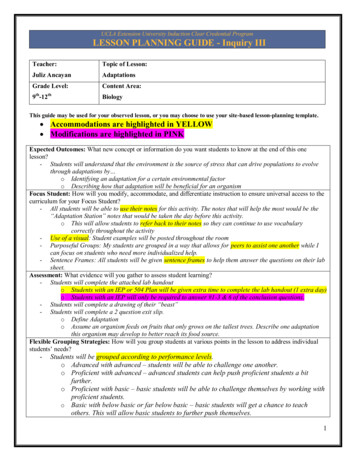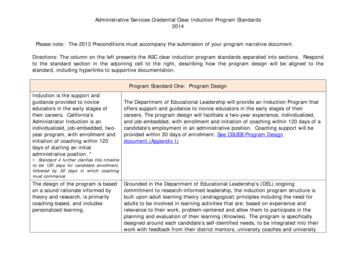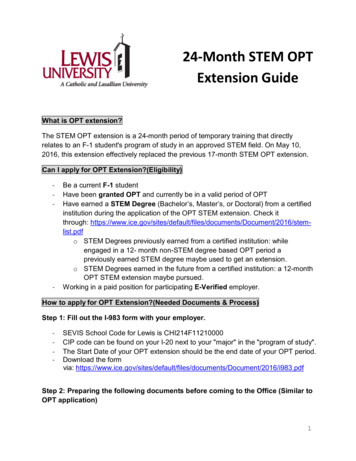
Transcription
\UCLA Extension University Induction Clear Credential ProgramLESSON PLANNING GUIDE - Inquiry IIITeacher:Topic of Lesson:Juliz AncayanAdaptationsGrade Level:Content Area:9th-12thBiologyThis guide may be used for your observed lesson, or you may choose to use your site-based lesson-planning template. Accommodations are highlighted in YELLOW Modifications are highlighted in PINKExpected Outcomes: What new concept or information do you want students to know at the end of this onelesson?- Students will understand that the environment is the source of stress that can drive populations to evolvethrough adaptations by o Identifying an adaptation for a certain environmental factoro Describing how that adaptation will be beneficial for an organismFocus Student: How will you modify, accommodate, and differentiate instruction to ensure universal access to thecurriculum for your Focus Student?- All students will be able to use their notes for this activity. The notes that will help the most would be the“Adaptation Station” notes that would be taken the day before this activity.o This will allow students to refer back to their notes so they can continue to use vocabularycorrectly throughout the activity- Use of a visual: Student examples will be posted throughout the room- Purposeful Groups: My students are grouped in a way that allows for peers to assist one another while Ican focus on students who need more individualized help.- Sentence Frames: All students will be given sentence frames to help them answer the questions on their labsheet.Assessment: What evidence will you gather to assess student learning?- Students will complete the attached lab handouto Students with an IEP or 504 Plan will be given extra time to complete the lab handout (1 extra day)o Students with an IEP will only be required to answer #1-3 & 6 of the conclusion questions.- Students will complete a drawing of their “beast”- Students will complete a 2 question exit slip.o Define Adaptationo Assume an organism feeds on fruits that only grows on the tallest trees. Describe one adaptationthis organism may develop to better reach its food source.Flexible Grouping Strategies: How will you group students at various points in the lesson to address individualstudents’ needs?-Students will be grouped according to performance levels.o Advanced with advanced – students will be able to challenge one another.o Proficient with advanced – advanced students can help push proficient students a bitfurther.o Proficient with basic – basic students will be able to challenge themselves by working withproficient students.o Basic with below basic or far below basic – basic students will get a chance to teachothers. This will allow basic students to further push themselves.1
What academic content standard(s) will you focus on during this lesson?NGSS Performance Expectation HS LS4-4: Construct an explanation based on evidence for how natural selectionleads to adaptation of population.Lesson Design: Describe each stage of your lesson in detail (e.g. Introduction, Modeling, Guided Practice,Independent Practice, Closing or Reflection)Introduction:- Teacher reviews what an adaptation is by referring to the previous day’s activityo What adaptations were helpful in dry environments?o What adaptations were helpful in rainy environments?o What adaptations were helpful in rocky environments?o Etc.- Teacher introduces the activity and passes out the lab hand out.o As a class, we will read and annotate the “Background” passage.o Teacher reviews symbols to use for annotations before starting.o Teacher reads 3-4 sentences and stops. Ask students what are some annotation symbols that can beused in the sentences that were just read.o Teacher popcorns to another student to read the next 3-4 sentences. Before popcorning to anotherstudent, go over which annotation symbols can be used in this section.o Repeat until passage is read.- Teacher reads the procedure to the students. While reading, have teacher annotate directions (under thedocument camera) to emphasize certain parts of the directions.o Make sure to tell students to annotate as well.o Call on 3-4 students to repeat procedure in their own words.Guided Practice- Teacher models the procedure to the students. Be sure to tell students to NOT follow procedure at the sametime. All students should be listening. No students should be writing.o Roll dice to determine ONE environmental factor.o Turn to chart and show students how to fill in the chart.o Explain that once the chart is filled in, students will get their chart checked by the teacher. Once theteacher approves the chart, students will be given their “drawing” paper and they will draw theirbeast in its environment.Independent Practice- Students work to complete their own chart.- Although this is individual, students may talk to others in their group for suggestions on adaptations.- Students may also use their notes to refer back to examples of adaptations in various environments.Closing and Reflection- Teacher tells students to clean up. Review vocabulary words that were practiced in this lesson (adaptation,natural selection, evolution).- Homework is to complete the conclusion questions.- Teacher passes out exit slip for students to answer.- Students work on the exit slip until the bell rings. Students turn in the exit slip to the teacher as they walkout the door.Student Engagement: Explain how your lesson ensures student engagement and differentiates for all learners.-Students will be rolling a dice to randomly choose environmental factors. This keeps students engagedbecause it is random and because having something to “play” with can keep them focused on the activity.Although students are making their OWN beast, they are still able to talk to and help one another as well asrefer back to their notes.Students will be drawing the beast that they created along with its environment. This will allow my artistic,yet quiet students to share their art skills with the class.
-I will let students know that their drawings will be posted around the classroom so students will be moreeager to put more effort in the drawing.Academic Vocabulary Instruction: What specific vocabulary/terms will you explicitly teach and have studentspractice during this lesson to ensure concept understanding?- Evolution, Adaptation, & Natural SelectionAsking Critical Questions: What specific questions will you pose to students to ensure thinking that requiresanalysis, evaluation, synthesis and application of content ideas across proficiency levels?Essential Question of the day: “What kinds of adaptation will help an organism survive in various environments?”Classroom Management: List any logistical, materials-related or behavioral issues you may need to consider toensure a safe and inclusive environment for student learning.-Students will be given a dice for this activity. If I feel students will not be able to handle dice (i.e., they willthrow it, break it, steal it, etc), then they will be given paper spinners and paper clips in place of die.Students may not be comfortable with drawing “crazy” creatures so I will show high, medium, and lowexamples from the past. I will emphasize that it’s not about the quality of the art, but about the quality ofthe adaptation.Integration of Technology: How will you integrate available technology resources into this lesson as you plan,teach, and assess student learning?-I will use a document camera to model reading and how to complete the assignment.I will use Google Slides and my projector to share instructions and show examples.3
Name Date PeriodBUILD-A-BEASTPlease talk-to-the-text before your begin the lab.BackgroundThis activity demonstrates an important part of evolution: adaptation.Adaptation is "an alteration or adjustment in structure or habits, often hereditary, by which aspecies or individual improves its condition in relationship to its environment.” In order tosurvive in an environment, a population needs to adapt. A trait can give animals an advantagewhere it lives. When an animal survives and is able to reproduce due to that trait we call it anadaptation. For example, mountain goats have padded hooves to grip the rocks on which theyclimb, giraffes are tall to reach the leaves of tall trees, and frogs have long, sticky tongues tocatch insects to eat, and are colored brown or green to match their environments so that predatorsdo not notice them. In fact, nearly everything about an animal is an adaptation of one kind oranother. Think of a trait that an animal has, and then think of how that trait helps it to survive orreproduce in its environment. Plants also adapt to their environments in order to survive. Forexample, cacti are able to store water because they live in dry places, and they have spines todiscourage animals from eating them. The flowers of flowering plants are an adaptation forattracting bees and butterflies, which enable the plant to reproduce.This activity is about creating animals with useful adaptations. The animal'senvironment is given, because that is how Darwin's theory of evolution and adaptationwork: the individual organisms that are best adapted to their particular environmentssurvive, so the adaptations gradually appear in more and more of the population.Different adaptations are helpful for different environments: For a rabbit living in theArctic, white fur would be helpful to avoid being seen by predators. For a rabbit livingin the woods, being white would make it more conspicuous, but being brown would behelpful.Procedure:1. To "build a beast," first roll a die for each category to determine the conditions under which theanimal lives.2. Then name and explain an adaptation your “beast” will have to help it survive due to thatenvironmental condition (page 4).3. Then make up and draw an animal (page 5) which has adaptations to be able to live well in that kindof environment. Be sure to include all adaptations and environmental factors in your drawing.4. Answer Conclusion questions (page 3).
Roll the dice and circle the corresponding environmental factor for each question below.A) WHERE DOES IT LIVE?1 - mountains2 - flat terrain3 - rocky, harsh4 - wetland5 - sandy6 - in a caveB) HOW MUCH FRESH WATER IS THERE?1 & 2 - almost none; dry and barren3 & 4 - water part of the year, drought the rest5 & 6 - lots of rain all yearC) WHAT IS THE CLIMATE/WEATHER LIKE?1 - hot and windy2 - hot all year3 - moderate4 - cold and windy5 - all four seasons6 - sub-zero temperaturesD) HOW MUCH AVAILABLE DAY LIGHT?1 & 2 - long days, short nights3 & 4 - short days, long nights5 & 6 - even days and nightsE) WHAT DOES IT EAT?1 - leaves from tall plants2 - fungus growing under rocks3 - berries, plants, and small animals4 - water animals5 - swift running deer-like animals6 - flying insectsF) WHAT EATS IT?1 - stompsuckers squash it flat2 - vampire butterflies land on it and suck it dry3 - buzzbugs lay eggs that burrow into its skin4 - web devils set gooey traps to catch it5 - ratrax packs are wolf-like and chase it6 - megaworms leap out of the sand and swallow it5
Conclusion: Use complete sentences to answer. Pages 297-301 of your textbook may be helpful.1. Explain the relationship between adaptation and natural selection.2. Explain the term fitness in regards to natural selection.3. Which of the six adaptations (page 4) for your organism do you think were the most important forsurvival? Explain why.4. Describe a change that would have to happen in your beast’s environment to cause the adaptation youchose in #3 to no longer be useful.5. Evolution is the change in a population over time. If the scenario you described in #4 were to occur, howwould the beast population evolve? Describe how the population may look generations from now.6. In each of the scenarios below identify the adaptation and then explain how that trait would benefit theorganism.a) In a jungle there are red bugs and green bugs. The birds prefer the taste of the red bugs, so soonthere are many green bugs and few red bugs.Adaptation:Explanation of adaptation:b) Peacock females pick their mate according to the male’s tail. The ones with the largest and brightesttails mate more often. Today, males that do not have bright feathers are very rare.Adaptation:Explanation of adaptation:
Fill in the table below. For each environmental factor name the adaptation (physical trait) and then explain how theadaptation is useful.For example:Birds eat flying insects. A frog’s main food source are also flying insects. Unlike the bird, frogs cannot fly after theirfood. How do they out compete the birds then? Frogs have tongues. Tongue length can vary among frogs making somefrogs better at getting food.Frog adaptation: Long tongueExplanation of adaptation: Frogs with longer tongues do not have to hop or move as much to catch their insects.Environmental FactorAnswer from rolling diceAdaptation (physicaltrait)Explanation of why theadaptation is beneficialWhere does it live?How much water is there?What is the climate/weatherlike?How much available lightis there?What does it eat?What eats it?7
Draw your “beast” showing all the adaptations and environmental conditions.
UCLA Extension University Induction Clear Credential Program LESSON PLANNING GUIDE - Inquiry III Teacher: Juliz Ancayan Topic of Lesson: Adaptations Grade Level: 9th-12th Content Area: Biology This guide may be used for your observed lesson, or you may choose to use your site-based lesson-planning template. Accommodations are highlighted in YELLOW










